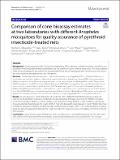| dc.description.abstract | ckground: Quality assurance (QA) of insecticide-treated nets (ITNs) delivered to malaria-endemic countries is con ducted by measuring physiochemical parameters, but not bioefcacy against malaria mosquitoes. This study explored
utility of cone bioassays for pre-delivery QA of pyrethroid ITNs to test the assumption that cone bioassays are consist ent across locations, mosquito strains, and laboratories.
Methods: Double-blinded bioassays were conducted on twenty unused pyrethroid ITNs of 4 brands (100 nets, 5
subsamples per net) that had been delivered for mass distribution in Papua New Guinea (PNG) having passed pre delivery inspections. Cone bioassays were performed on the same net pieces following World Health Organization
(WHO) guidelines at the PNG Institute of Medical Research (PNGIMR) using pyrethroid susceptible Anopheles farauti
sensu stricto (s.s.) and at Ifakara Health Institute (IHI), Tanzania using pyrethroid susceptible Anopheles gambiae s.s.
Additionally, WHO tunnel tests were conducted at IHI on ITNs that did not meet cone bioefcacy thresholds. Results
from IHI and PNGIMR were compared using Spearman’s Rank correlation, Bland–Altman (BA) analysis and analysis of
agreement. Literature review on the use of cone bioassays for unused pyrethroid ITNs testing was conducted.
Results: In cone bioassays, 13/20 nets (65%) at IHI and 8/20 (40%) at PNGIMR met WHO bioefcacy criteria. All
nets met WHO bioefcacy criteria on combined cone/tunnel tests at IHI. Results from IHI and PNGIMR correlated
on 60-min knockdown (KD60) (rs=0.6,p=0.002,n=20) and 24-h mortality (M24) (rs=0.9,p<0.0001,n=20) but BA
showed systematic bias between the results. Of the 5 nets with discrepant result between IHI and PNGIMR, three had
confdence intervals overlapping the 80% mortality threshold, with averages within 1–3% of the threshold. Including
these as a pass, the agreement between the results to predict ITN failure was good with kappa=0.79 (0.53–1.00) and
90% accuracy.
Conclusions: Based on these study fndings, the WHO cone bioassay is a reproducible bioassay for ITNs with>80%
M24, and for all ITNs provided inherent stochastic variation and systematic bias are accounted for. The literature | en_US |

